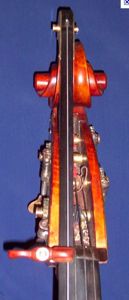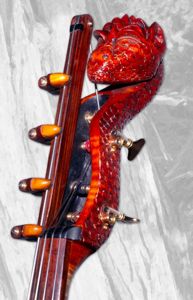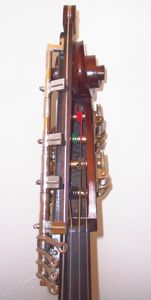Hi friends, For the curious, here's some general bass info I've found, much gleaned from wiki.... Please excuse the lengthy post. The "bass violin" as we know it has been around since the "violin" family of instruments was invented somewhere in 15th century Europe. There was also a "viol" family of instruments, as in viola da gamba, which developed around that time but it seems violin, viola, cello and bass became the more common lineup (maybe just because they were louder!) In the early days I'm sure there were many variations but reportedly the first basses had only 3-strings were built to double the cello an octave lower (unlike that monster two-man job danno linked to above which according to that article could play C0 - TWO octaves below the cello, yikes!). For time reference, Stradavari built his most well-known instruments (Series II?) between 1690-1737. How today's standard tuning came about is a point of contention among historians. The "double-bass" is the only member of the violin family tuned in 4ths, the rest are in 5ths. Some say it's a descendant of the other "viol" family which used tunings closer to guitar; 4ths with a 3rd in the middle. But the physical construction of the bass links it more directly to the violin family. My own personal theory (a-hem!) is that somebody decided the long strings made it impractical to play if tuned in 5ths because of the left hand reach involved in just playing a scale. But that's just my weak guess. However it happened, low-E somehow became the norm. But then composers started writing for lower notes (Strauss's "Also Sprach Zarathustra" written in 1896 starts with the low-C) and so the bass mods began. Here in the US, Canada and the UK, orchestra bassists started adding an "extension" to the E string which allowed the string to continue to the end of the scroll. Here are 3 examples:



The first and simplest version has a lock you can clamp to make an open E and then swing aside and make an open low-C. The problem was if you had to play a low D-flat you really had to reach for it. The second one included individual "fingers" which you could lock to make any of the notes the open string. A practical solution as long as you didn't need to move very fast. Cool scroll on that one too! The third pic is a version often just called a "machine" which added keyed "fingers" on concentric shafts so you could more quickly move between those notes... My dad used this "machine" version for years and then eventually switched to a 5-string setup with a low-B. And I think I remember him saying that Mahler wrote something that called for what he referred to as the "killer-B". A couple other notes here away from the classical side of things... Reportedly in 1966 the late jazz bassist Red Mitchell switched his upright 4-string to a 5ths tuning with a low-C on the bottom. I think there are a handful of guys still playing this way and I'm sure it opens up some interesting possibilities. I'm not too familiar with his work but do remember the great Ron Carter making my ears perk up when he started playing low-Ds. He had added an extension like the first pic above in about 1971 and that's a pretty popular solution now. My brother has that same setup. And that is ALL I know about acoustic bass as I never got my license to operate one in public. HA! Cheers, Jimmy J